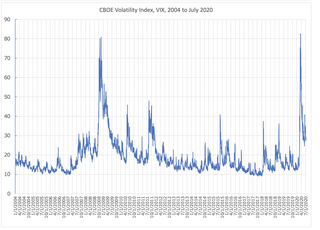Related Research Articles
Finance is the study and discipline of money, currency and capital assets. It is related to, but not synonymous with economics, which is the study of production, distribution, and consumption of goods and services; the discipline of financial economics bridges the two. Financial activities take place in financial systems at various scopes; thus, the field can be roughly divided into personal, corporate, and public finance.
In finance, a high-yield bond is a bond that is rated below investment grade by credit rating agencies. These bonds have a higher risk of default or other adverse credit events, but offer higher yields than investment-grade bonds in order to compensate for the increased risk.
Financial economics is the branch of economics characterized by a "concentration on monetary activities", in which "money of one type or another is likely to appear on both sides of a trade". Its concern is thus the interrelation of financial variables, such as share prices, interest rates and exchange rates, as opposed to those concerning the real economy. It has two main areas of focus: asset pricing and corporate finance; the first being the perspective of providers of capital, i.e. investors, and the second of users of capital. It thus provides the theoretical underpinning for much of finance.
Financial risk is any of various types of risk associated with financing, including financial transactions that include company loans in risk of default. Often it is understood to include only downside risk, meaning the potential for financial loss and uncertainty about its extent.

VIX is the ticker symbol and the popular name for the Chicago Board Options Exchange's CBOE Volatility Index, a popular measure of the stock market's expectation of volatility based on S&P 500 index options. It is calculated and disseminated on a real-time basis by the CBOE, and is often referred to as the fear index or fear gauge.
In mathematical finance, the SABR model is a stochastic volatility model, which attempts to capture the volatility smile in derivatives markets. The name stands for "stochastic alpha, beta, rho", referring to the parameters of the model. The SABR model is widely used by practitioners in the financial industry, especially in the interest rate derivative markets. It was developed by Patrick S. Hagan, Deep Kumar, Andrew Lesniewski, and Diana Woodward.
A Constant proportion debt obligation (CPDO) is a type of credit derivative sold to investors looking for exposure to credit risk. A CPDO is normally embedded in a note rated by a credit rating agency. CPDOs employ dynamic leveraging in a similar way to Credit CPPI trades.
Alternative beta is the concept of managing volatile "alternative investments", often through the use of hedge funds. Alternative beta is often also referred to as "alternative risk premia".
In finance, model risk is the risk of loss resulting from using insufficiently accurate models to make decisions, originally and frequently in the context of valuing financial securities. However, model risk is more and more prevalent in activities other than financial securities valuation, such as assigning consumer credit scores, real-time probability prediction of fraudulent credit card transactions, and computing the probability of air flight passenger being a terrorist. Rebonato in 2002 defines model risk as "the risk of occurrence of a significant difference between the mark-to-model value of a complex and/or illiquid instrument, and the price at which the same instrument is revealed to have traded in the market".
Risk parity is an approach to investment management which focuses on allocation of risk, usually defined as volatility, rather than allocation of capital. The risk parity approach asserts that when asset allocations are adjusted to the same risk level, the risk parity portfolio can achieve a higher Sharpe ratio and can be more resistant to market downturns than the traditional portfolio. Risk parity is vulnerable to significant shifts in correlation regimes, such as observed in Q1 2020, which led to the significant underperformance of risk-parity funds in the Covid-19 sell-off.
Jonathan Kinlay is a quantitative researcher and hedge fund manager. He is founder and CEO of Systematic Strategies, LLC, a systematic hedge fund that deploys high-frequency trading strategies using news-based algorithms.
Quantitative analysis is the use of mathematical and statistical methods in finance and investment management. Those working in the field are quantitative analysts (quants). Quants tend to specialize in specific areas which may include derivative structuring or pricing, risk management, investment management and other related finance occupations. The occupation is similar to those in industrial mathematics in other industries. The process usually consists of searching vast databases for patterns, such as correlations among liquid assets or price-movement patterns.

Moody's Analytics is a subsidiary of Moody's Corporation established in 2007 to focus on non-rating activities, separate from Moody's Investors Service. It provides economic research regarding risk, performance and financial modeling, as well as consulting, training and software services. Moody's Analytics is composed of divisions such as Moody's KMV, Moody's Economy.com, Moody's Wall Street Analytics, the Institute of Risk Standards and Qualifications, and Canadian Securities Institute Global Education Inc.
Campbell Russell "Cam" Harvey is a Canadian economist, known for his work on asset allocation with changing risk and risk premiums and the problem of separating luck from skill in investment management. He is currently the J. Paul Sticht Professor of International Business at Duke University's Fuqua School of Business in Durham, North Carolina, as well as a research associate with the National Bureau of Economic Research in Cambridge, Massachusetts. He is also a research associate with the Institute of International Integration Studies at Trinity College Dublin and a visiting researcher at the University of Oxford. He served as the 2016 president of the American Finance Association.

In investing and finance, the low-volatility anomaly is the observation that low-volatility stocks have higher returns than high-volatility stocks in most markets studied. This is an example of a stock market anomaly since it contradicts the central prediction of many financial theories that taking higher risk must be compensated with higher returns.

The DAO was a digital decentralized autonomous organization and a form of investor-directed venture capital fund. After launching in April 2016 via a token sale, it became one of the largest crowdfunding campaigns in history, but it ceased activity after much of its funds were taken in a hack in June 2016.
Low-volatility investing is an investment style that buys stocks or securities with low volatility and avoids those with high volatility. This investment style exploits the low-volatility anomaly. According to financial theory risk and return should be positively related, however in practice this is not true. Low-volatility investors aim to achieve market-like returns, but with lower risk. This investment style is also referred to as minimum volatility, minimum variance, managed volatility, smart beta, defensive and conservative investing.
David C. Blitz is a Dutch econometrician and quantitative researcher on financial markets. He is a founding researcher of Robeco Quantitative Investments.
Conservative formula investing is an investment technique that uses the principles of low-volatility investing and is enhanced with momentum and net payout yield signals.
Pim van Vliet is a Dutch fund manager and head of conservative equities at Robeco Quantitative Investments.
References
- ↑ "SSRN author page". privpapers.ssrn.com. Archived from the original on 2023-02-04. Retrieved 2021-09-16.
- ↑ "Amazon author page: Eric Falkenstein". www.amazon.com. Archived from the original on 2023-02-04. Retrieved 2021-09-16.
- 1 2 Falkenstein, Eric (1994). "Mutual Funds, Idiosyncratic Variance, and Asset Returns". ResearchGate . Retrieved 2021-10-05.
- ↑ "Moody's Analytics RiskCalc" (PDF). Moody's Analytics . Archived (PDF) from the original on 2023-02-04. Retrieved 2021-10-05.
- ↑ "User Eric Falkenstein". Ethereum Stack Exchange. Archived from the original on 2023-02-04. Retrieved 2021-10-05.
- ↑ Mattich, Alen (2010-12-30). "The Best Economics Blogs" . Wall Street Journal . ISSN 0099-9660. Archived from the original on 2023-02-04. Retrieved 2021-09-16.
- ↑ Falkenstein, Eric. "Preferences for stock characteristics as revealed by mutual fund portfolio holdings". The Journal of Finance (March 1996 ed.). 51 (1). Archived from the original on 2023-02-04. Retrieved 2021-09-16.
- ↑ Falkenstein, Eric. "Minimizing Basis Risk From Nonparallel Shifts in the Yield Curve". The Journal of Fixed Income (June 1996 ed.).
- ↑ Falkenstein, Eric. "Value-at-Risk and Derivatives Risk". Derivatives Quarterly (Fall 1997 ed.).
- ↑ Cowen, Tyler (September 20, 2009). "Eric Falkenstein's *Finding Alpha*". Marginal REVOLUTION. Archived from the original on 2021-10-04. Retrieved 2021-10-04.
- ↑ Upbin, Bruce. "One Hedge Fund Ace's Essential Investor Reading List". Forbes. Retrieved 2021-10-05.
- ↑ "Falkenblog". Falkenblog. Archived from the original on 2021-09-15. Retrieved 2021-09-15.